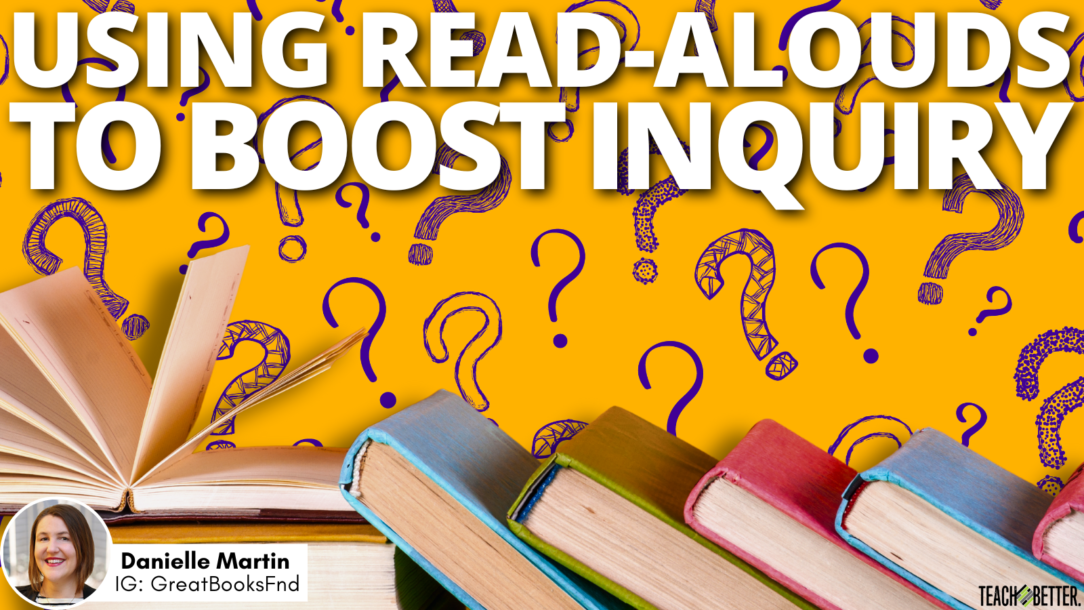TL;DR:
- Reading aloud enhances inquiry-centered learning and fosters joy in the classroom.
- It improves vocabulary, models fluent reading, and benefits auditory learners.
- Active listening during read-alouds promotes self-awareness, social-emotional learning, and positive associations with reading, especially beneficial for older students.
Reading texts aloud to your students—no matter what their age or independent reading level—is a great way to intensify inquiry-centered learning. It also serves a crucial purpose: to connect learning with joy in the classroom.
It’s also important to point out that reading aloud shouldn’t be siloed to rug time or a way to relax after PE. Abundant research1 has shown that reading aloud to students builds their vocabularies, provides a model of fluent reading, and meets the needs of auditory learners. Irene Fountas and Gay Su Pinnell’s2 work has documented how interactive read-alouds enable students to experience higher-level texts and build “shared literary knowledge.” To the last point, it’s clear that read-alouds contribute to social and emotional learning. They also help to build a learning community to increase peer-to-peer engagement.
Reading texts aloud to your students is a great way to intensify inquiry-centered learning. It also serves a crucial purpose: to connect learning with joy in the classroom. - Danielle M. Click To TweetFostering Self-Awareness and Positive Associations
While listening as a text is read aloud, students have the opportunity to practice self-awareness and self-management. Learning to listen actively, avoid distracting others, and follow along as they hear the text requires students to focus and demonstrate respect for others. And as they listen, students also learn to associate reading with the positive emotions of being part of a community and doing something enjoyable.
This may seem paradoxical, but older elementary, middle school, and high school students particularly benefit from this practice. For these groups, who may have had negative experiences with reading, listening to texts promises to change their self-perception. Because of their increased ability to understand ideas, they are more able to respond to their peers and build on each other’s ideas. As Lisa Hollihan Allen, a middle school literary interventionist, wrote in the Wisconsin English Journal, “Reading aloud provides positive experiences. Sharing a compelling, enjoyable, important, or funny book with their classmates can be powerful. They start to trust that reading can be a good thing and that maybe this teacher knows what she’s doing.”
Five Tips for Using Read-Alouds for Inquiry-Based Learning
1. To focus on inquiry, choose short texts.
Especially when you are combining listening to a text with responding to it, readings of limited length allow for both activities within a class period. Students will also find it easier to hold the entirety of a shorter text in mind when asking questions or exploring reactions.
2. Welcome all questions.
After every few pages, ask students to share what they are wondering about, and post questions for everyone to see. Then, at the end of the reading, help students process which questions have been answered. Also having students practice asking what they’re wondering about or confused about helps create a norm centered around support and wondering.
3. Consider incorporating nonverbal signals.
Sometimes it’s difficult to have all students share their replies. To diversify participation, have students use simple hand gestures to indicate surprise, agreement, or disagreement. This can help them stay focused and allow the teacher to track their reactions.
4. Give spaces for students to share their opinions.
In addition to questions, have students share their favorite part of a text or their strongest reaction. Make it clear that the purpose is not to grade or judge responses, but to listen to varied perspectives as part of a learning community.
5. Emphasize that one reading is only the beginning!
Emphasize to students that confusion about some parts of a reading is natural and that rereading is an opportunity to deepen understanding. After hearing a text read aloud, have students reread or re-listen to it with their questions in mind.
[scroll down to keep reading]Junior Great Books Provides Multiple Opportunities
Read-alouds are known as an opportunity for a whole classroom to focus on the joy of words. But when leveraged well, it’s also an opportunity to allow students to connect their critical thinking with their speaking and listening skills. Junior Great Books is one of many programs that provide critical read-aloud opportunities. The program carefully selects many short, wonderful texts for grades K–8 that are meant to be read aloud in class.
These texts, in fiction, nonfiction, and poetry, include questions and activities teachers can use to allow students to explore and share their thoughts with each other and in writing. Classroom materials for all levels include recordings of every text that students can listen to any time to increase their understanding and boost their levels of participation in discussion.
Notes
- Okello, Dr. Betsy. “The Power of Read Alouds.” University of Notre Dame Center for Literacy Education. January 28, 2021.
- Fountas & Pinnell Literacy Team. “What Is Interactive Read-Aloud?” Fountas & Pinnell Literacy Blog. January 25, 2019.
About Danielle Martin
Danielle Martin is an educational consultant for the Great Books Foundation. She has more than 15 years of experience as a teacher, curriculum developer, and instructional coach. She holds an EdM from the Harvard Graduate School of Education and an MA in theater history and criticism from Catholic University.




